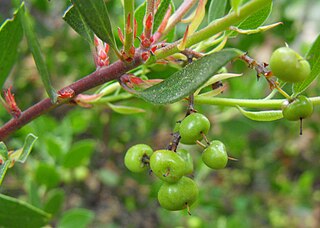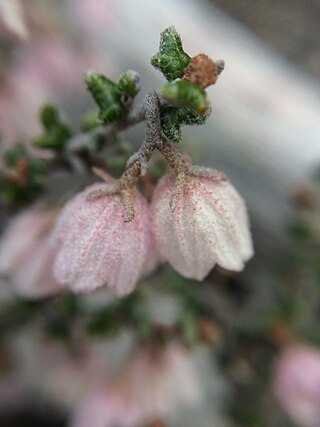
Ziziphus is a genus of about 40 species of spiny shrubs and small trees in the buckthorn family, Rhamnaceae, distributed in the warm-temperate, subtropical and tropical regions of the world. The leaves are alternate, entire, with three prominent basal veins, and 2–7 cm (0.79–2.76 in) long; some species are deciduous, others evergreen. The flowers are small, inconspicuous yellow-green. The fruit is an edible drupe, yellow-brown, red, or black, globose or oblong, 1–5 cm (0.39–1.97 in) long, often very sweet and sugary, reminiscent of a date in texture and flavour.

Adonis is a genus of about 20–30 species of flowering plants of the crowfoot family, Ranunculaceae, native to Europe and Asia.

Akebia is a genus of five species of flowering plant, within the family Lardizabalaceae. The scientific name, akebia, is a Latinization of the Japanese name for the species Akebia quinata: akebi (通草).

Akebia quinata, commonly known as chocolate vine, five-leaf chocolate vine, or five-leaf akebia, is a shrub that is native to Japan, China and Korea, commonly used as an ornamental / edible plant in the United States and Europe In its native habitat, it is often found on hills, in hedges, on trees, along forest edges and streams, and on mountainous slopes.

Spondias mombin, also known as yellow mombin, hog plum or amra, is a species of tree and flowering plant in the family Anacardiaceae. It is native to the tropical Americas, including the West Indies. The tree was introduced by the Portuguese in South Asia in the beginning of the 17th century. It has been naturalized in parts of Africa, India, Nepal, Bangladesh, Sri Lanka, The Bahamas, Indonesia, and other Caribbean islands. It is rarely cultivated except in parts of the Brazilian Northeast.

Guichenotia is a genus of 17 species of flowering plants in the family Malvaceae that is endemic to the south west of Western Australia. Plants in the genus Guichenotia are shrubs with simple, linear to oblong leaves with leaf-like stipules at the base of the petiole, the flowers bisexual with three bracteoles at the base of the sepals, and five petal-like sepals, the petals sometimes absent. The fruit is a capsule usually containing 15 seeds.

Nestegis apetala is a small tree native to northern New Zealand and to Norfolk Island. The common names in New Zealand are coastal maire or broad-leaved maire. On Norfolk Island, the common name is ironwood. The species name apetala refers to the lack of petals on the flowers.

Nestegis is a genus of flowering plant in the olive family, Oleaceae. There are five currently accepted species in the genus: three species are endemic to New Zealand, while one can be found on New Zealand and Norfolk Island. Another is restricted to Hawaiʻi.

Apetala 2(AP2) is a gene and a member of a large family of transcription factors, the AP2/EREBP family. In Arabidopsis thaliana AP2 plays a role in the ABC model of flower development. It was originally thought that this family of proteins was plant-specific; however, recent studies have shown that apicomplexans, including the causative agent of malaria, Plasmodium falciparum encode a related set of transcription factors, called the ApiAP2 family.

Arctostaphylos stanfordiana, with the common name Stanford's manzanita, is a species of manzanita that is endemic to northern California. It is known from the outer North Coast Ranges north of the San Francisco Bay Area.

Not to be confused with Factor Inhibiting HIF Asparaginyl Hydroxylase Inhibitors

Stellaria apetala, lesser chickweed, is an annual herbaceous plant in the flowering plant family Caryophyllaceae. It occurs in short, sandy grassland by the sea and, less often, in similar habitat inland. It is native to Europe and is well established as an introduced species worldwide.

Sterculia apetala, commonly known as the Panama tree, camoruco, manduvi tree or anacagüita, is a species of flowering plants in the family Malvaceae. It is found in Central and South America, as well as the Caribbean islands. Sterculia apetala is recognized as the national tree of the Republic of Panama.

Pomaderris apetala is a small tree or large shrub from the family Rhamnaceae, growing in Victoria, New Zealand and Tasmania.
The micrantha is a wild citrus from the papeda group, native to southern Philippines, particularly islands of Cebu and Bohol. Two varieties are recognized: small-flowered papeda, locally known as biasong, and small-fruited papeda or samuyao.
Prunus apetala is a species of flowering cherry in the genus Prunus in the family Rosaceae. It is called clove cherry, because of its clovebud-shaped calyx. It is native to Japan, centered on the main island, Honshu.

Akebia trifoliata also known as chocolate vine,three leaf chocolate vine or three leaf akebia, is a species of flowering plant. It is a close relative of the more commonly known Akebia quinata.

Akebia chingshuiensis is a member of the Akebia family native to China. It is a rarer species of Akebia and has a smaller range than Akebia trifoliata or Akebia quinata.
Guichenotia anota is a flowering plant in the family Malvaceae and is endemic to a restricted part of the southwest of Western Australia. It is a low, erect, compact shrub with hairy new growth, oblong to narrowly egg-shaped leaves, and pinkish-purple flowers.

Guichenotia apetala is a flowering plant in the family Malvaceae and is endemic to a small area in the southwest of Western Australia. It is a small, erect, compact shrub with many branches, densely hairy new growth, triangular to heart-shaped leaves, and salmon pink flowers.
















